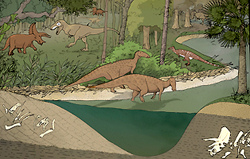From a Few Bones, the Most Primitive Snake Emerges
Researchers at Yale have identified an ancient slithering creature from the time of T. rex as the most primitive known snake, a finding with implications for the debate over snake origins.
“It’s the missing-link snake,” said Nicholas Longrich, a postdoctoral fellow in Yale’s Department of Geology & Geophysics and the lead author of a paper about the lizard-like snake published July 25 online in the journal Nature. “It’s the ‘Lucy’ of snakes.”
The paper argues that snakes descend from terrestrial rather than marine ancestors, as recently proposed by others, and that snakes emerged once lizards developed long, limbless bodies for burrowing. (more…)

